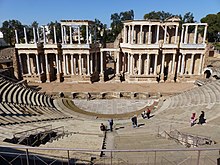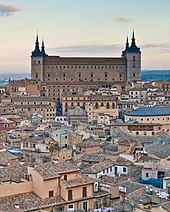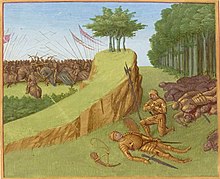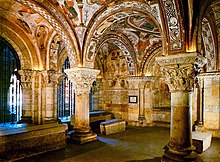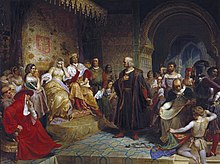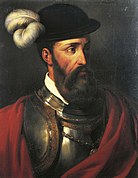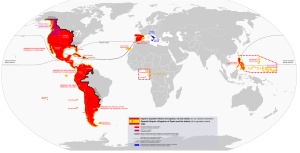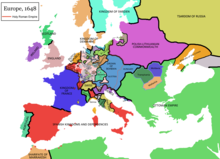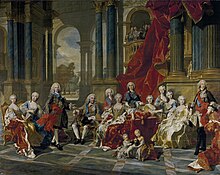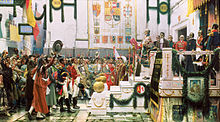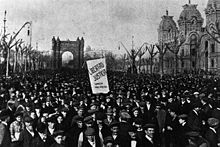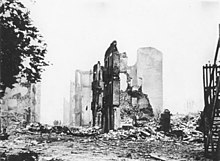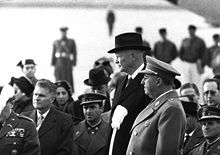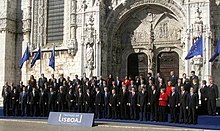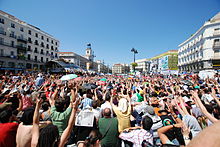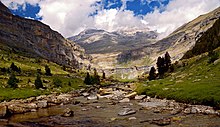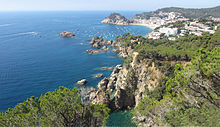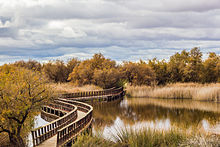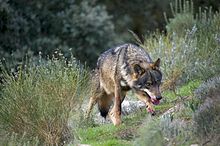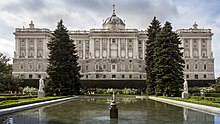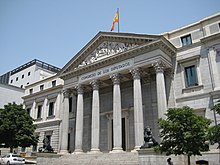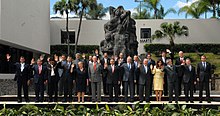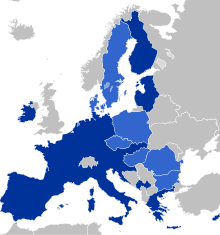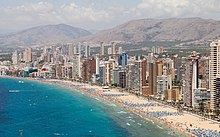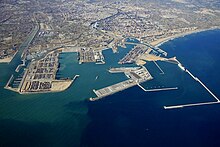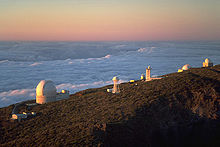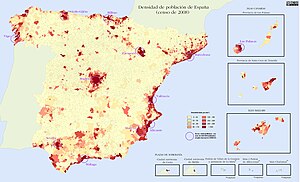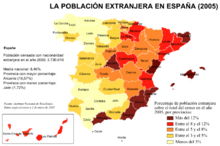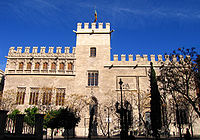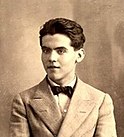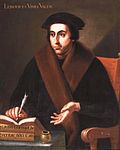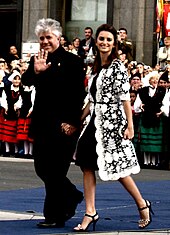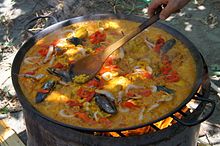Spain
Definition
Spain (Spanish: España [esˈpaɲa] (With an area of 505,990 km (195,360 sq mi), Spain is the largest country in Southern Europe, the second largest country in Western Europe and the European Union, and the fourth largest country in the European continent. By population, Spain is the sixth largest in Europe and the fifth in the European Union. Spain's capital and largest city is Madrid; other major urban areas include Barcelona, Valencia, Seville, Málaga and Bilbao.
Modern humans first arrived in the Iberian Peninsula around 35,000 years ago. Iberian cultures along with ancient Phoenician, Greek and Carthaginiansettlements developed on the peninsula until it came under Roman rule around 200 BCE, after which the region was named Hispania, based on the earlier Phoenician name Sp(a)n or Spania. At the end of the Western Roman Empire the Germanic tribal confederations migrated from Central Europe, invaded the Iberian peninsula and established relatively independent realms in its western provinces, including the Suebi, Alans and Vandals. Eventually, the Visigoths would forcibly integrate all remaining independent territories in the peninsula, including Byzantine provinces, into the Kingdom of Toledo, which more or less unified politically, ecclesiastically and legally all the former Roman provinces or successor kingdoms of what was then documented as Hispania.
In the early eighth century the Visigothic kingdom fell to the Moors, who arrived to rule most of the peninsula in the year 726, leaving only a handful of small Christian realms in the north, lasting up to seven centuries in the Kingdom of Granada. This led to many wars during a long reconquering period across the Iberian Peninsula, which led to the creation of Kingdom of Leon, Kingdom of Castille, Kingdom of Aragon and Kingdom of Navarre as the main Christian kingdoms to face the invasion. Following the Moorish conquest, Europeans began a gradual process of retaking the region known as the Reconquista, which by the late 15th century culminated in the emergence of Spain as a unified country under the Catholic Monarchs.
In the early modern period, Spain became the world's first global empire and the most powerful country in the world, leaving a vast cultural and linguistic legacy that includes over 500 million Hispanophones, making Spanish language the world's second most spoken native language, after Mandarin Chinese. During the Golden Age there were also many advancements in the arts, with world-famous painters such as Diego Velázquez. The most famous Spanish literary work, Don Quixote, was also published during the Golden Age.
Spain is a secular parliamentary democracy and constitutional monarchy, with King Felipe VI as head of state. It is a major developed country and a high income country, with the world's fourteenth largest economy by nominal GDP and sixteenth largest by purchasing power parity. It is a member of the United Nations (UN), the European Union (EU), the Eurozone, the Council of Europe (CoE), the Organization of Ibero-American States (OEI), the Union for the Mediterranean, the North Atlantic Treaty Organization (NATO), the Organisation for Economic Co-operation and Development (OECD), OSCE, the Schengen Area, the World Trade Organization (WTO) and many other international organisations. Spain has a "permanent invitation" to the G20 summits that occur generally once a year.
Etymology
The origins of the Roman name Hispania, from which the modern name España was derived, are uncertain due to inadequate evidence, although it is documented that the Phoenicians and Carthaginians referred to the region as Spania, therefore the most widely accepted etymology is a Semitic-Phoenicianone. Down the centuries there have been a number of accounts and hypotheses:
The Renaissance scholar Antonio de Nebrija proposed that the word Hispania evolved from the Iberian word Hispalis, meaning "city of the western world".
Jesús Luis Cunchillos argues that the root of the term span is the Phoenician word spy, meaning "to forge metals". Therefore, i-spn-ya would mean "the land where metals are forged". It may be a derivation of the Phoenician I-Shpania, meaning "island of rabbits", "land of rabbits" or "edge", a reference to Spain's location at the end of the Mediterranean; Roman coins struck in the region from the reign of Hadrian show a female figure with a rabbit at her feet, and Strabo called it the "land of the rabbits".
Hispania may derive from the poetic use of the term Hesperia, reflecting the Greek perception of Italy as a "western land" or "land of the setting sun" (Hesperia, Ἑσπερία in Greek) and Spain, being still further west, as Hesperia ultima.
There is the claim that "Hispania" derives from the Basque word Ezpanna meaning "edge" or "border", another reference to the fact that the Iberian Peninsula constitutes the southwest corner of the European continent.
Two 15th-century Spanish Jewish scholars, Don Isaac Abravanel and Solomon ibn Verga, gave an explanation now considered folkloric. Both men wrote in two different published works that the first Jews to reach Spain were brought by ship by Phiros who was confederate with the king of Babylon when he laid siege to Jerusalem. Phiros was a Grecian by birth, but who had been given a kingdom in Spain. Phiros became related by marriage to Espan, the nephew of king Heracles, who also ruled over a kingdom in Spain. Heracles later renounced his throne in preference for his native Greece, leaving his kingdom to his nephew, Espan, from whom the country of España (Spain) took its name. Based upon their testimonies, this eponym would have already been in use in Spain by c. 350 BCE.
History
Iberia enters written records as a land populated largely by the Iberians, Basques and Celts. Early on its coastal areas were settled by Phoenicians who founded Western Europe's most ancient cities Cadiz and Malaga. Phoenician influence expanded as much of the Peninsula was eventually incorporated into the Carthaginian Empire, becoming a major theatre of the Punic Wars against the expanding Roman Empire. After an arduous conquest, the peninsula came fully under Roman Rule. During the early Middle Ages it came under Germanic rule but later, much of it was conquered by Moorish invaders from North Africa. In a process that took centuries, the small Christian kingdoms in the north gradually regained control of the peninsula. The last Moorish kingdom fell in the same year Columbus reached the Americas. A global empire began which saw Spain become the strongest kingdom in Europe, the leading world power for a century and a half, and the largest overseas empire for three centuries.
Continued wars and other problems eventually led to a diminished status. The Napoleonic invasions of Spain led to chaos, triggering independence movements that tore apart most of the empire and left the country politically unstable. Prior to the Second World War, Spain suffered a devastating civil war and came under the rule of an authoritarian government, which oversaw a period of stagnation that was followed by a surge in the growth of the economy. Eventually democracy was peacefully restored in the form of a parliamentary constitutional monarchy. Spain joined the European Union, experiencing a cultural renaissance and steady economic growth until the beginning of the 21st century, that started a new globalised world with economic and ecological challenges.
Prehistory and pre-Roman peoples
Archaeological research at Atapuerca indicates the Iberian Peninsula was populated by hominids 1.2 million years ago. In Atapuerca fossils have been found of the earliest known hominins in Europe, the Homo antecessor. Modern humans first arrived in Iberia, from the north on foot, about 35,000 years ago. The best known artefacts of these prehistoric human settlements are the famous paintings in the Altamira cave of Cantabria in northern Iberia, which were created from 35,600 to 13,500 BCE by Cro-Magnon. Archaeological and genetic evidence suggests that the Iberian Peninsula acted as one of several major refugia from which northern Europe was repopulated following the end of the last ice age.
The largest groups inhabiting the Iberian Peninsula before the Roman conquest were the Iberians and the Celts. The Iberians inhabited the Mediterranean side of the peninsula, from the northeast to the southeast. The Celts inhabited much of the inner and Atlantic sides of the peninsula, from the northwest to the southwest. Basques occupied the western area of the Pyrenees mountain range and adjacent areas, the Phoenician-influenced Tartessians culture flourished in the southwest and the Lusitanians and Vettones occupied areas in the central west. A number of cities were founded along the coast by Phoenicians, and trading outposts and colonies were established by Greeks in the East. Eventually, Phoenician-Carthaginians expanded inland towards the meseta, however due to the bellicose inland tribes the Carthaginians got settled in the coasts of the Iberian Peninsula.
Roman Hispania and the Visigothic Kingdom
During the Second Punic War, roughly between 210 and 205 BC the expanding Roman Republic captured Carthaginian trading colonies along the Mediterranean coast. Although it took the Romans nearly two centuries to complete the conquest of the Iberian Peninsula, they retained control of it for over six centuries. Roman rule was bound together by law, language, and the Roman road.
The cultures of the Celtic and Iberian populations were gradually Romanised (Latinised) at different rates depending on what part of Hispania they lived in, with local leaders being admitted into the Roman aristocratic class. Hispania served as a granary for the Roman market, and its harbours exported gold, wool, olive oil, and wine. Agricultural production increased with the introduction of irrigation projects, some of which remain in use. Emperors Hadrian, Trajan, Theodosius I, and the philosopher Seneca were born in Hispania. Christianity was introduced into Hispania in the 1st century AD and it became popular in the cities in the 2nd century AD.Most of Spain's present languages and religion, and the basis of its laws, originate from this period.
The weakening of the Western Roman Empire's jurisdiction in Hispania began in 409, when the Germanic Suebi and Vandals, together with the Sarmatian Alans entered the peninsula at the invitation of a Roman usurper. These tribes had crossed the Rhine in early 407 and ravaged Gaul. The Suebi established a kingdom in what is today modern Galicia and northern Portugal whereas the Vandals established themselves in southern Spain by 420 before crossing over to North Africa in 429 and taking Carthage in 439. As the western empire disintegrated, the social and economic base became greatly simplified: but even in modified form, the successor regimes maintained many of the institutions and laws of the late empire, including Christianity and assimilation to the evolving Roman culture.
The Byzantines established an occidental province, Spania, in the south, with the intention of reviving Roman rule throughout Iberia. Eventually, however, Hispania was reunited under Visigothic rule.
The Spanish-Gothic scholars such as Braulio of Zaragoza and Isidore of Seville played an important role in keeping the classical Greek and Roman culture. Isidore was one of the most influential clerics and philosophers in the Middle Ages in Europe, and his theories were also vital to the conversion of the Visigothic Kingdom from an Arian domain to a Catholic one in the Councils of Toledo. This Gothic kingdom was the first independent Christian kingdom ruling in the Iberian Peninsula, and in the Reconquista it was the referent for the different kingdoms fighting against the Muslim rule. Isidore created the first western encyclopaedia which had a huge impact during the Middle Ages.
Middle Ages: Muslim era and Reconquista
In the 8th century, nearly all of the Iberian Peninsula was conquered (711–718) by largely Moorish Muslim armies from North Africa. These conquests were part of the expansion of the Umayyad Caliphate. Only a small area in the mountainous north-west of the peninsula managed to resist the initial invasion.
Under Islamic law, Christians and Jews were given the subordinate status of dhimmi. This status permitted Christians and Jews to practice their religions as People of the Book but they were required to pay a special tax and had legal and social rights inferior to those of Muslims.
Conversion to Islam proceeded at an increasing pace. The muladíes (Muslims of ethnic Iberian origin) are believed to have comprised the majority of the population of Al-Andalus by the end of the 10th century.
The Muslim community in the Iberian Peninsula was itself diverse and beset by social tensions. The Berber people of North Africa, who had provided the bulk of the invading armies, clashed with the Arab leadership from the Middle East. Over time, large Moorish populations became established, especially in the Guadalquivir Rivervalley, the coastal plain of Valencia, the Ebro River valley and (towards the end of this period) in the mountainous region of Granada.
Córdoba, the capital of the caliphate since Abd-ar-Rahman III, was the largest, richest and most sophisticated city in western Europe. Mediterranean trade and cultural exchange flourished. Muslims imported a rich intellectual tradition from the Middle East and North Africa. Some important philosophers at the time were Averroes, Ibn Arabi and Maimonides. The Romanised cultures of the Iberian Peninsula interacted with Muslim and Jewish cultures in complex ways, giving the region a distinctive culture.Outside the cities, where the vast majority lived, the land ownership system from Roman times remained largely intact as Muslim leaders rarely dispossessed landowners and the introduction of new crops and techniques led to an expansion of agriculture introducing new produces which originally came from Asia or the former territories of the Roman Empire.
In the 11th century, the Muslim holdings fractured into rival Taifa kingdoms, allowing the small Christian states the opportunity to greatly enlarge their territories. The arrival from North Africa of the Islamic ruling sects of the Almoravids and the Almohads restored unity upon the Muslim holdings, with a stricter, less tolerant application of Islam, and saw a revival in Muslim fortunes. This re-united Islamic state experienced more than a century of successes that partially reversed Christian gains.
The Reconquista (Reconquest) was the centuries-long period in which Christian rule was re-established over the Iberian Peninsula. The Reconquista is viewed as beginning with the Battle of Covadonga won by Don Pelayo in 722 and was concurrent with the period of Muslim rule on the Iberian Peninsula. The Christian army's victory over Muslim forces led to the creation of the Christian Kingdom of Asturias along the northwestern coastal mountains. Shortly after, in 739, Muslim forces were driven from Galicia, which was to eventually host one of medieval Europe's holiest sites, Santiago de Compostela and was incorporated into the new Christian kingdom. The Kingdom of León was the strongest Christian kingdom for centuries. In 1188 the first modern parliamentary session in Europe was held in León (Cortes of León). The Kingdom of Castile, formed from Leonese territory, was its successor as strongest kingdom. The kings and the nobility fought for power and influence in this period. The example of the Roman emperors influenced the political objective of the Crown, while the nobles benefited from feudalism.
Muslim armies had also moved north of the Pyrenees but they were defeated by Frankish forces at the Battle of Poitiers, Frankia and pushed out of the very southernmost region of France along the seacoast by the 760s. Later, Frankish forces established Christian counties on the southern side of the Pyrenees. These areas were to grow into the kingdoms of Navarre and Aragon. For several centuries, the fluctuating frontier between the Muslim and Christian controlled areas of Iberia was along the Ebroand Douro valleys.
The County of Barcelona and the Kingdom of Aragon entered in a dynastic union and gained territory and power in the Mediterranean. In 1229 Majorca was conquered, so was Valencia in 1238.
The break-up of Al-Andalus into the competing taifa kingdoms helped the long embattled Iberian Christian kingdoms gain the initiative. The capture of the strategically central city of Toledo in 1085 marked a significant shift in the balance of power in favour of the Christian kingdoms. Following a great Muslim resurgence in the 12th century, the great Moorish strongholds in the south fell to Christian Spain in the 13th century—Córdoba in 1236 and Seville in 1248. In the 13th and 14th centuries, the Marinid dynasty of Morocco invaded and established some enclaves on the southern coast but failed in their attempt to re-establish North African rule in Iberia and were soon driven out. After 800 years of Muslim presence in Spain, the last Nasrid sultanate of Granada, a tributary state would finally surrender in 1492 to the Catholic monarchs Queen Isabella I of Castile and King Ferdinand II of Aragon.
From the mid 13th century, literature and philosophy started to flourish again in the Christian peninsular kingdoms, based on Roman and Gothic traditions. An important philosopher from this time is Ramon Llull. Abraham Cresqueswas a prominent Jewish cartographer. Roman law and its institutions were the model for the legislators. The king Alfonso X of Castile focused on strengthening this Roman and Gothic past, and also on linking the Iberian Christian kingdoms with the rest of medieval European Christendom. Alfonso worked for being elected emperor of the Holy Roman Empire and published the Siete Partidas code. The Toledo School of Translators is the name that commonly describes the group of scholars who worked together in the city of Toledo during the 12th and 13th centuries, to translate many of the philosophical and scientific works from Classical Arabic, Ancient Greek, and Ancient Hebrew.
The Islamic transmission of the classics is the main Islamic contributions to Medieval Europe. The Castilian language—more commonly known (especially later in history and at present) as "Spanish" after becoming the national language and lingua francaof Spain—evolved from Vulgar Latin, as did other Romance languages of Spain like the Catalan, Asturian and Galician languages, as well as other Romance languages in Latin Europe. Basque, the only non-Romance language in Spain, continued evolving from Early Basque to Medieval. The Glosas Emilianenses founded in the monasteries of San Millán de la Cogolla contain the first written words in both Basque and Spanish, having the first become an influence in the formation of the second as an evolution of Latin.
The 13th century also witnessed the Crown of Aragon, centred in Spain's north east, expand its reach across islands in the Mediterranean, to Sicily and even Athens.Around this time the universities of Palencia (1212/1263) and Salamanca (1218/1254) were established. The Black Death of 1348 and 1349 devastated Spain.
Spanish Empire
In 1469, the crowns of the Christian kingdoms of Castile and Aragon were united by the marriage of Isabella I of Castile and Ferdinand II of Aragon. 1478 commenced the completion of the conquest of the Canary Islands and in 1492, the combined forces of Castile and Aragon captured the Emirate of Granada from its last ruler Muhammad XII, ending the last remnant of a 781-year presence of Islamic rule in Iberia. That same year, Spain's Jews were ordered to convert to Catholicism or face expulsion from Spanish territories during the Spanish Inquisition. The Treaty of Granada guaranteed religious tolerance towards Muslims, for a few years before Islam was outlawed in 1502 in the Kingdom of Castile and 1527 in the Kingdom of Aragon, leading to Spain's Muslim population becoming nominally Christian Moriscos. A few decades after the Morisco rebellion of Granada known as the War of the Alpujarras, a significant proportion of Spain's formerly-Muslim population was expelled, settling primarily in North Africa.
The year 1492 also marked the arrival of Christopher Columbus in the New World, during a voyage funded by Isabella. Columbus's first voyage crossed the Atlantic and reached the Caribbean Islands, beginning the European exploration and conquest of the Americas, although Columbus remained convinced that he had reached the Orient. The colonisation of the Americas started, with conquistadores like Hernán Cortés and Francisco Pizarro. Miscegenation was the rule between the native and the Spanish cultures and people.
As Renaissance New Monarchs, Isabella and Ferdinand centralised royal power at the expense of local nobility, and the word España, whose root is the ancient name Hispania, began to be commonly used to designate the whole of the two kingdoms. With their wide-ranging political, legal, religious and military reforms, Spain emerged as the first world power.
The unification of the crowns of Aragon and Castile by the marriage of their sovereigns laid the basis for modern Spain and the Spanish Empire, although each kingdom of Spain remained a separate country socially, politically, legally, and in currency and language.
There were two big revolts against the new Habsburg monarch and the more authoritarian and imperial-style crown: Revolt of the Comuneros in Castile and Revolt of the Brotherhoods in Majorca and Valencia. After years of combat, Comuneros Juan López de Padilla, Juan Bravo and Francisco Maldonado were executed and María Pacheco went into exile. Germana de Foix also finished with the revolt in the Mediterranean.
Spain was Europe's leading power throughout the 16th century and most of the 17th century, a position reinforced by trade and wealth from colonial possessions and became the world's leading maritime power. It reached its apogee during the reigns of the first two Spanish Habsburgs—Charles I (1516–1556) and Philip II (1556–1598). This period saw the Italian Wars, the Revolt of the Comuneros, the Dutch Revolt, the Morisco Revolt, clashes with the Ottomans, the Anglo-Spanish War and wars with France.
Through exploration and conquest or royal marriage alliances and inheritance, the Spanish Empire expanded to include vast areas in the Americas, islands in the Asia-Pacific area, areas of Italy, cities in Northern Africa, as well as parts of what are now France, Germany, Belgium, Luxembourg, and the Netherlands. The first circumnavigation of the world was carried out in 1519–1521. It was the first empire on which it was said that the sun never set. This was an Age of Discovery, with daring explorations by sea and by land, the opening-up of new trade routes across oceans, conquests and the beginnings of European colonialism. Spanish explorers brought back precious metals, spices, luxuries, and previously unknown plants, and played a leading part in transforming the European understanding of the globe. The cultural efflorescence witnessed during this period is now referred to as the Spanish Golden Age. The expansion of the empire caused immense upheaval in the Americas as the collapse of societies and empires and new diseases from Europe devastated American indigenous populations. The rise of humanism, the Counter-Reformation and new geographical discoveries and conquests raised issues that were addressed by the intellectual movement now known as the School of Salamanca, which developed the first modern theories of what are now known as international law and human rights. Juan Luis Viveswas another prominent humanist during this period.
In the late 16th century and first half of the 17th century, Spain was confronted by unrelenting challenges from all sides. Barbary pirates, under the aegis of the rapidly growing Ottoman Empire, disrupted life in many coastal areas through their slave raids and the renewed threat of an Islamic invasion. This was at a time when Spain was often at war with France.
The Protestant Reformation dragged the kingdom ever more deeply into the mire of religiously charged wars. The result was a country forced into ever expanding military efforts across Europe and in the Mediterranean.
By the middle decades of a war- and plague-ridden 17th-century Europe, the Spanish Habsburgs had enmeshed the country in continent-wide religious-political conflicts. These conflicts drained it of resources and undermined the economy generally. Spain managed to hold on to most of the scattered Habsburg empire, and help the imperial forces of the Holy Roman Empire reverse a large part of the advances made by Protestant forces, but it was finally forced to recognise the separation of Portugal (with whom it had been united in a personal union of the crowns from 1580 to 1640) and the Netherlands, and eventually suffered some serious military reverses to France in the latter stages of the immensely destructive, Europe-wide Thirty Years' War.
In the latter half of the 17th century, Spain went into a gradual decline, during which it surrendered several small territories to France and the Netherlands; however, it maintained and enlarged its vast overseas empire, which remained intact until the beginning of the 19th century.
The decline culminated in a controversy over succession to the throne which consumed the first years of the 18th century. The War of the Spanish Succession was a wide-ranging international conflict combined with a civil war, and was to cost the kingdom its European possessions and its position as one of the leading powers on the Continent. During this war, a new dynasty originating in France, the Bourbons, was installed. Long united only by the Crown, a true Spanish state was established when the first Bourbon king, Philip V, united the crowns of Castile and Aragon into a single state, abolishing many of the old regional privileges and laws.
The 18th century saw a gradual recovery and an increase in prosperity through much of the empire. The new Bourbon monarchy drew on the French system of modernising the administration and the economy. Enlightenment ideas began to gain ground among some of the kingdom's elite and monarchy. Military assistance for the rebellious British colonies in the American War of Independence improved the kingdom's international standing.
Liberalism, labour movement and nation state
In 1793, Spain went to war against the revolutionary new French Republic as a member of the first Coalition. The subsequent War of the Pyrenees polarised the country in a reaction against the gallicised elites and following defeat in the field, peace was made with France in 1795 at the Peace of Basel in which Spain lost control over two-thirds of the island of Hispaniola. The Prime Minister, Manuel Godoy, then ensured that Spain allied herself with France in the brief War of the Third Coalition which ended with the British victory at the Battle of Trafalgar in 1805. In 1807, a secret treaty between Napoleon and the unpopular prime minister led to a new declaration of war against Britain and Portugal. Napoleon's troops entered the country to invade Portugal but instead occupied Spain's major fortresses. The ridiculed Spanish king abdicated in favour of Napoleon's brother, Joseph Bonaparte.
Joseph Bonaparte was seen as a puppet monarch and was regarded with scorn by the Spanish. The 2 May 1808 revolt was one of many nationalist uprisings across the country against the Bonapartist regime. These revolts marked the beginning of a devastating war of independence against the Napoleonic regime. Napoleon was forced to intervene personally, defeating several Spanish armies and forcing a British army to retreat. However, further military action by Spanish armies, guerrillas and Wellington's British-Portuguese forces, combined with Napoleon's disastrous invasion of Russia, led to the ousting of the French imperial armies from Spain in 1814, and the return of King Ferdinand VII.
During the war, in 1810, a revolutionary body, the Cortes of Cádiz, was assembled to co-ordinate the effort against the Bonapartist regime and to prepare a constitution. It met as one body, and its members represented the entire Spanish empire. In 1812, a constitution for universal representation under a constitutional monarchy was declared, but after the fall of the Bonapartist regime, Ferdinand VII dismissed the Cortes Generales and was determined to rule as an absolute monarch. These events foreshadowed the conflict between conservatives and liberals in the 19th and early 20th centuries.
Spain's conquest by France benefited Latin American anti-colonialists who resented the Imperial Spanish government's policies that favoured Spanish-born citizens (Peninsulars) over those born overseas (Criollos) and demanded retroversion of the sovereignty to the people. Starting in 1809 Spain's American colonies began a series of revolutions and declared independence, leading to the Spanish American wars of independence that ended Spanish control over its mainland colonies in the Americas. King Ferdinand VII's attempt to re-assert control proved futile as he faced opposition not only in the colonies but also in Spain and army revolts followed, led by liberal officers. By the end of 1826, the only American colonies Spain held were Cuba and Puerto Rico.
The Napoleonic War left Spain economically ruined, deeply divided and politically unstable. In the 1830s and 1840s Anti-liberal forces known as Carlists fought against liberals in the Carlist Wars. Liberal forces won, but the conflict between progressive and conservative liberals ended in a weak early constitutional period. After the Glorious Revolution of 1868 and the short-lived First Spanish Republic, a more stable monarchic period began characterised by the practice of turnismo (the rotation of government control between progressive and conservative liberals within the Spanish government).
In the late 19th century nationalist movements arose in the Philippines and Cuba. In 1895 and 1896 the Cuban War of Independence and the Philippine Revolution broke out and eventually the United States became involved. The Spanish–American War was fought in the spring of 1898 and resulted in Spain losing the last of its once vast colonial empire outside of North Africa. El Desastre (the Disaster), as the war became known in Spain, gave added impetus to the Generation of '98 who were conducting an analysis of the country.
Although the period around the turn of the century was one of increasing prosperity, the 20th century brought little peace; Spain played a minor part in the scramble for Africa, with the colonisation of Western Sahara, Spanish Morocco and Equatorial Guinea. It remained neutral during World War I (see Spain in World War I). The heavy losses suffered during the Rif War in Morocco brought discredit to the government and undermined the monarchy.
Second Spanish Republic
After a period of authoritarian rule under General Miguel Primo de Rivera (1923–1931), the king determined to seek a solution to the political situation and establish the Constitution, the king led the municipal elections on April 12, 1931. These gave a resounding victory to the Republican-Socialist candidacies in large cities and provincial capitals, well the total number of councillors was mostly monarchical. The organised demonstrations demanding the establishment of a democratic republic led the king to leave the country and the proclamation of the same on April 14 of that same year. During the Second Republic there was a great political and social upheaval, marked by a sharp radicalisation of the left and the right. The moderate leaders were boycotted and each party intended to create a Spain to suit them. During the first two years, governed a coalition of republican and socialist parties. In the elections held in 1933 the right triumphed and in 1936, the left. The violent acts during this period included the burning of churches, the monarchical uprising of the militar José Sanjurjo, the Revolution of 1934 and numerous attacks against rival political leaders. On the other hand, it is also during the Second Republic when important reforms are initiated to modernise the country -democratic constitution, agrarian reform, restructuring of the army, first Statutes of Autonomy...- and the rights of citizens as the recognition of women's right to vote, establishing universal suffrage.
On July 17 and 18, 1936, revolted against the government of the Republic, the military garrisons of the Spanish North Africa, coup d'état that triumphs only in part country. Spain was divided into two zones: one under the authority of the Republican government -in which the social revolution of 1936- and other controlled by the insurgents took place. The situation led to a Civil War, in which the general Francisco Franco was sworn in as the supreme leader of the insurgents.
Spanish Civil War and Francoist Spain
The Spanish Civil War broke out in 1936. For three years the Nationalist forces led by General Francisco Franco and supported by Nazi Germany and Fascist Italy fought the Republican side, which was supported by the Soviet Union, Mexico and International Brigades but it was not supported by the Western powers due to the British-led policy of Non-Intervention. The civil war was viciously fought and there were many atrocities committed by all sides. The war claimed the lives of over 500,000 people and caused the flight of up to a half-million citizens from the country. In 1939, General Franco emerged victorious and became a dictator.
The state as established under Franco was nominally neutral in the Second World War, although sympathetic to the Axis. The only legal party under Franco's post civil war regime was the Falange Española Tradicionalista y de las JONS, formed in 1937; the party emphasised falangism, a form of fascism that emphasised anti-communism, nationalism and Roman Catholicism. Given Franco's opposition to competing political parties, the party was renamed the National Movement (Movimiento Nacional) in 1949.
After World War II Spain was politically and economically isolated, and was kept out of the United Nations. This changed in 1955, during the Cold War period, when it became strategically important for the US to establish a military presence on the Iberian Peninsula as a counter to any possible move by the Soviet Union into the Mediterranean basin. In the 1960s, Spain registered an unprecedented rate of economic growth which was propelled by industrialisation, a mass internal migration from rural areas to Madrid, Barcelona and the Basque Country and the creation of a mass tourism industry. Franco's rule was also characterised by authoritarianism, promotion of a unitary national identity, the favouring of a very conservative form of Roman Catholicism known as National Catholicism, and discriminatory language policies.
Restoration of democracy
In 1962, a group of politicians involved in the opposition to Franco's regime inside the country and in the exile met in the congress of the European Movement in Munich, where they made a resolution in favour of democracy.
With Franco's death in November 1975, Juan Carlos succeeded to the position of King of Spain and head of state in accordance with the franquist law. With the approval of the new Spanish Constitution of 1978 and the restoration of democracy, the State devolved much authority to the regions and created an internal organisation based on autonomous communities. The Spanish 1977 Amnesty Law let people of Franco's regime continue inside institutions without consequences, even perpetrators of some crimes during transition to democracy like the Massacre of 3 March 1976 in Vitoria or 1977 Massacre of Atocha. The 'founding chairman' of the current leading political party in Spain, the People's Party, was Manuel Fraga who had been a minister in Franco's government and yet continued with his political career until shortly before his death in 2012.
In the Basque Country, moderate Basque nationalism has coexisted with a radical nationalist movement led by the armed terrorist organisation ETA. The group was formed in 1959 during Franco's rule but has continued to wage its violent campaign even after the restoration of democracy and the return of a large measure of regional autonomy.
On 23 February 1981, rebel elements among the security forces seized the Cortes in an attempt to impose a military-backed government. King Juan Carlos took personal command of the military and successfully ordered the coup plotters, via national television, to surrender.
During the 1980s the democratic restoration made possible a growing open society. New cultural movements based on freedom appeared, like La Movida Madrileña and a culture of human rights arose with Gregorio Peces-Barba. On 30 May 1982 Spain joined NATO, followed by a referendum after a strong social opposition. That year the Spanish Socialist Workers Party (PSOE) came to power, the first left-wing government in 43 years. In 1986 Spain joined the European Economic Community, which later became the European Union. The PSOE was replaced in government by the Partido Popular (PP) in 1996 after scandals around participation of the government of Felipe González in the Dirty war against ETA; at that point the PSOE had served almost 14 consecutive years in office.
On 1 January 2002, Spain fully adopted the euro, and Spain experienced strong economic growth, well above the EU average during the early 2000s. However, well-publicised concerns issued by many economic commentators at the height of the boom warned that extraordinary property prices and a high foreign trade deficit were likely to lead to a painful economic collapse.
In 2002 the Prestige oil spill occurred with big ecological consequences along Spain's Atlantic coastline. In 2003 José María Aznar supported US president George W. Bush in the Iraq War, and a strong movement against war rose in Spanish society. On 11 March 2004 a local Islamist terrorist group inspired by Al-Qaeda carried out the largest terrorist attack in Spanish history when they killed 191 people and wounded more than 1,800 others by bombing commuter trains in Madrid. Though initial suspicions focused on the Basque terrorist group ETA, evidence soon emerged indicating Islamist involvement. Because of the proximity of the 2004 election, the issue of responsibility quickly became a political controversy, with the main competing parties PP and PSOE exchanging accusations over the handling of the incident. The elections on 14 March were won by the PSOE, led by José Luis Rodríguez Zapatero.
The proportion of Spain's foreign born population increased rapidly during its economic boom in the early 2000s, but then declined due to the financial crisis. In 2005 the Spanish government legalised same sex marriage. Decentralisation was supported with much resistance of Constitutional Court and conservative opposition, so did gender politics like quotas or the law against gender violence. Government talks with ETA happened, and the group announced its permanent cease of violence in 2010.
The bursting of the Spanish property bubble in 2008 led to the 2008–16 Spanish financial crisis and high levels of unemployment, cuts in government spending and corruption in Royal family and People's Party served as a backdrop to the 2011–12 Spanish protests. Catalan independentism was also on rise. In 2011, Mariano Rajoy's conservative People's Party won the election with 44.6% of votes, and Rajoy became the Spanish Prime Minister, after having been the leader of the opposition from 2004 to 2011, and continued to implement austerity measures required by the EU Stability and Growth Pact. On 19 June 2014, the monarch, Juan Carlos, abdicated in favour of his son, who became Felipe VI.
A Catalan independence referendum was held on 1 October 2017 and then, on 27 October, the Catalan parliament voted to unilaterally declare independence from Spainto form a Catalan Republic on the day the Spanish Senate was discussing approving direct rule over Catalonia as called for by the Spanish Prime Minister.Later that day the Senate granted the power to impose direct rule and Mr Rajoy dissolved the Catalan parliament and called a new election. No country recognised Catalonia as a separate state.
On 1 June 2018 the Congress of Deputies passed a motion of no-confidence against Rajoy and replaced him with the PSOE leader Pedro Sanchez, thus bringing socialists back to power after 7 years.
Geography
At 505,992 km (195,365 sq mi), Spain is the world's fifty-second largest country and Europe's fourth largest country. It is some 47,000 km (18,000 sq mi) smaller than France and 81,000 km (31,000 sq mi) larger than the US state of California. Mount Teide (Tenerife) is the highest mountain peak in Spain and is the third largest volcano in the world from its base. Spain is a transcontinental country.
Spain lies between latitudes 26° and 44° N, and longitudes 19° W and 5° E.
On the west, Spain is bordered by Portugal; on the south, it is bordered by Gibraltar (a British overseas territory) and Morocco, through its exclaves in North Africa (Ceutaand Melilla, and the peninsula of Vélez de la Gomera). On the northeast, along the Pyrenees mountain range, it is bordered by France and the Principality of Andorra. Along the Pyrenees in Girona, a small exclave town called Llívia is surrounded by France.
Extending to 1,214 km (754 mi), the Portugal–Spain border is the longest uninterrupted border within the European Union.
Islands
Spain also includes the Balearic Islands in the Mediterranean Sea, the Canary Islands in the Atlantic Ocean and a number of uninhabited islands on the Mediterranean side of the Strait of Gibraltar, known as plazas de soberanía ("places of sovereignty", or territories under Spanish sovereignty), such as the Chafarinas Islands and Alhucemas. The peninsula of Vélez de la Gomera is also regarded as a plaza de soberanía. The isle of Alborán, located in the Mediterranean between Spain and North Africa, is also administered by Spain, specifically by the municipality of Almería, Andalusia. The little Pheasant Island in the River Bidasoa is a Spanish-French condominium.
Largest inhabited islands of Spain:
| Island | Population |
|---|---|
| Tenerife | 899,833 |
| Majorca (Mallorca) | 862,397 |
| Gran Canaria | 838,397 |
| Lanzarote | 141,938 |
| Ibiza (Eivissa) | 125,053 |
| Fuerteventura | 103,107 |
| Menorca | 92,434 |
| La Palma | 85,933 |
Mountains and rivers
Mainland Spain is a mountainous country, dominated by high plateaus and mountain chains. After the Pyrenees, the main mountain ranges are the Cordillera Cantábrica(Cantabrian Range), Sistema Ibérico (Iberian System), Sistema Central (Central System), Montes de Toledo, Sierra Morena and the Sistema Bético (Baetic System) whose highest peak, the 3,478-metre-high (11,411-foot) Mulhacén, located in Sierra Nevada, is the highest elevation in the Iberian Peninsula. The highest point in Spain is the Teide, a 3,718-metre (12,198 ft) active volcano in the Canary Islands. The Meseta Central (often translated as "Inner Plateau") is a vast plateau in the heart of peninsular Spain.
There are several major rivers in Spain such as the Tagus (Tajo), Ebro, Guadiana, Douro (Duero), Guadalquivir, Júcar, Segura, Turia and Minho (Miño). Alluvial plainsare found along the coast, the largest of which is that of the Guadalquivir in Andalusia.
Climate
Three main climatic zones can be separated, according to geographical situation and orographic conditions:
- The Mediterranean climate, characterised by warm/hot and dry summers, is dominant in the peninsula. It has two varieties: Csa and Csb according to the Köppen climate classification.
- The Csa zone is associated to areas with hot summers. It is predominant in the Mediterranean and Southern Atlantic coast and inland throughout Andalusia, Extremadura and much, if not most, of the centre of the country. The Csa zone covers climatic zones with both relatively warm and cold winters which are considered extremely different to each other at a local level, reason for which Köppen classification is often eschewed within Spain. Local climatic maps generally divide the Mediterranean zone (which covers most of the country) between warm-winter and cold-winter zones, rather than according to summer temperatures.
- The Csb zone has warm rather than hot summers, and extends to additional cool-winter areas not typically associated with a Mediterranean climate, such as much of central and northern-central of Spain (e.g. western Castile–León, northeastern Castilla-La Mancha and northern Madrid) and into much rainier areas (notably Galicia). Note areas with relatively high rainfall such as Galicia are not considered Mediterranean under local classifications, but classed as oceanic.
- The semi-arid climate (BSk, BSh), is predominant in the southeastern quarter of the country, but is also widespread in other areas of Spain. It covers most of the Region of Murcia, southern Valencia and eastern Andalusia, where true hot desert climates also exist. Further to the north, it is predominant in the upper and mid reaches of the Ebro valley, which crosses southern Navarre, central Aragon and western Catalonia. It also is found in Madrid, Extremadura, Castilla-La Mancha, and some locations of western Andalusia. The dry season extends beyond the summer and average temperature depends on altitude and latitude.
- The oceanic climate (Cfb), located in the northern quarter of the country, especially in the Atlantic region (Basque Country, Cantabria, Asturias, and partly Galicia and Castile–León). Additionally it is also found in northern Navarre, in most highlands areas along the Iberian System and in the Pyrenean valleys, where a humid subtropical variant (Cfa) also occurs. Winter and summer temperatures are influenced by the ocean, and have no seasonal drought.
Apart from these main types, other sub-types can be found, like the alpine climate in areas with very high altitude, the humid subtropical climate in areas of northeastern Spain and the continental climates (Dfc, Dfb / Dsc, Dsb) in the Pyrenees as well as parts of the Cantabrian Range, the Central System, Sierra Nevada and the Iberian System, and a typical desert climate (BWk, BWh) in the zone of Almería, Murcia and eastern Canary Islands. Low-lying areas of the Canary Islands average above 18.0 °C (64.4 °F) during their coldest month, thus having a tropical climate.
Fauna and flora
The fauna presents a wide diversity that is due in large part to the geographical position of the Iberian peninsula between the Atlantic and the Mediterranean and between Africa and Eurasia, and the great diversity of habitats and biotopes, the result of a considerable variety of climates and well differentiated regions.
The vegetation of Spain is varied due to several factors including the diversity of the relief, the climate and latitude. Spain includes different phytogeographic regions, each with its own floristic characteristics resulting largely from the interaction of climate, topography, soil type and fire, biotic factors.
Politics
According to the Democracy Index of the EIU, Spain is one of the 19 full democracies in the world.
The Spanish Constitution of 1978 is the culmination of the Spanish transition to democracy. The constitutional history of Spain dates back to the constitution of 1812. Impatient with the slow pace of democratic political reforms in 1976 and 1977, Spain's new King Juan Carlos, known for his formidable personality, dismissed Carlos Arias Navarro and appointed the reformer Adolfo Suárez as Prime Minister. The resulting general election in 1977 convened the Constituent Cortes (the Spanish Parliament, in its capacity as a constitutional assembly) for the purpose of drafting and approving the constitution of 1978. After a national referendum on 6 December 1978, 88% of voters approved of the new constitution.
As a result, Spain is now composed of 17 autonomous communities and two autonomous cities with varying degrees of autonomy thanks to its Constitution, which nevertheless explicitly states the indivisible unity of the Spanish nation. The constitution also specifies that Spain has no state religion and that all are free to practice and believe as they wish.
The Spanish administration approved legislation in 2007 aimed at furthering equality between genders in Spanish political and economic life (Gender Equality Act). However, in the legislative branch, as of May 2017 only 140 of the 350 members of the Congress were women (40%). It places Spain 12th on a list of countries ranked by proportion of women in the lower house. In the Senate, there are only 101 women out of 263 (38.0%). The Gender Empowerment Measure of Spain in the United Nations Human Development Report is 0.794, 12th in the world.
Government
Spain is a constitutional monarchy, with a hereditary monarch and a bicameral parliament, the Cortes Generales (General Courts). The executive branch consists of a Council of Ministers of Spain presided over by the Prime Minister, nominated and appointed by the monarch and confirmed by the Congress of Deputies following legislative elections. By political custom established by King Juan Carlos since the ratification of the 1978 Constitution, the king's nominees have all been from parties who maintain a plurality of seats in the Congress.
The legislative branch is made up of the Congress of Deputies (Congreso de los Diputados) with 350 members, elected by popular vote on block lists by proportional representation to serve four-year terms, and a Senate (Senado) with 259 seats of which 208 are directly elected by popular vote, using a limited voting method, and the other 51 appointed by the regional legislatures to also serve four-year terms.
- Head of State
- King Felipe VI, since 19 June 2014
- Head of Government
- Prime Minister of Spain (Presidente del Gobierno, literally President of the Government): Pedro Sánchez Pérez-Castejón, elected 1 June 2018.
- Deputy Prime Minister and Minister for the Presidency: Soraya Sáenz de Santamaría (in office).
- Prime Minister of Spain (Presidente del Gobierno, literally President of the Government): Pedro Sánchez Pérez-Castejón, elected 1 June 2018.
- Cabinet
- Council of Ministers (Consejo de Ministros) designated by the Prime Minister.
Spain is organisationally structured as a so-called Estado de las Autonomías ("State of Autonomies"); it is one of the most decentralised countries in Europe, along with Switzerland, Germany and Belgium; for example, all autonomous communities have their own elected parliaments, governments, public administrations, budgets, and resources. Health and education systems among others are managed by the Spanish communities, and in addition, the Basque Country and Navarre also manage their own public finances based on foral provisions. In Catalonia, the Basque Country, Navarre and the Canary Islands, a full-fledged autonomous police corps replaces some of the State police functions (see Mossos d'Esquadra, Ertzaintza, Policía Foral/Foruzaingoa and Policía Canaria).
Human rights
The Spanish Constitution of 1978 "protect all Spaniards and all the peoples of Spain in the exercise of human rights, their cultures and traditions, languages and institutions".
According to Amnesty International (AI), government investigations of alleged police abuses are often lengthy and punishments were light. Violence against women was a problem, which the Government took steps to address.
Spain provides one of the highest degrees of liberty in the world for its LGBT community. Among the countries studied by Pew Research Center in 2013, Spain is rated first in acceptance of homosexuality, with an 88% of society supporting the gay community compared to 11% who do not.
Administrative divisions
The Spanish State is integrated by 17 autonomous communities and 2 autonomous cities, both groups being the highest or first-order administrative division in the country. Autonomous communities are integrated by provinces, of which there are 50 in total, and in turn, provinces are integrated by municipalities. In Catalonia, two additional divisions exist, the comarques (sing. comarca) and the vegueries (sing. vegueria) both of which have administrative powers; comarques being aggregations of municipalities, and the vegueries being aggregations of comarques. The concept of a comarca exists in all autonomous communities, however, unlike Catalonia, these are merely historical or geographical subdivisions.
Autonomous communities

The basic institutional law of each autonomous community is the Statute of Autonomy. The Statutes of Autonomy establish the name of the community according to its historical and contemporary identity, the limits of its territories, the name and organisation of the institutions of government and the rights they enjoy according to the constitution.
The governments of all autonomous communities must be based on a division of powers comprising:
- a legislative assembly whose members must be elected by universal suffrage according to the system of proportional representation and in which all areas that integrate the territory are fairly represented;
- a government council, with executive and administrative functions headed by a president, elected by the Legislative Assembly and nominated by the King of Spain;
- a supreme court, under the supreme court of Spain, which heads the judiciary in the autonomous community.
Catalonia, Galicia and the Basque Country, which identified themselves as nationalities, were granted self-government through a rapid process. Andalusia also took that denomination in its first Statute of Autonomy, even though it followed the longer process stipulated in the constitution for the rest of the country. Progressively, other communities in revisions to their Statutes of Autonomy have also taken that denomination in accordance to their historical and modern identities, such as the Valencian Community, the Canary Islands, the Balearic Islands, and Aragon.
The autonomous communities have wide legislative and executive autonomy, with their own parliaments and regional governments. The distribution of powers may be different for every community, as laid out in their Statutes of Autonomy, since devolution was intended to be asymmetrical. Only two communities—the Basque Country and Navarre—have full fiscal autonomy. Aside of fiscal autonomy, the nationalities—Andalusia, the Basque Country, Catalonia, and Galicia—were devolved more powers than the rest of the communities, among them the ability of the regional president to dissolve the parliament and call for elections at any time. In addition, the Basque Country, Catalonia and Navarre have police corps of their own: Ertzaintza, Mossos d'Esquadra and the Policía Foral respectively. Other communities have more limited forces or none at all, like the Policía Autónoma Andaluza in Andalusia or the BESCAM in Madrid.
Nonetheless, recent amendments to existing Statutes of Autonomy or the promulgation of new Statutes altogether, have reduced the asymmetry between the powers originally granted to the nationalities and the rest of the regions.
Finally, along with the 17 autonomous communities, two autonomous cities are also part of the State of Autonomies and are first-order territorial divisions: Ceuta and Melilla. These are two exclaves located in the northern African coast.
Provinces and municipalities
Autonomous communities are subdivided into provinces, which served as their territorial building blocks. In turn, provinces are integrated by municipalities. The existence of both the provinces and the municipalities is guaranteed and protected by the constitution, not necessarily by the Statutes of Autonomy themselves. Municipalities are granted autonomy to manage their internal affairs, and provinces are the territorial divisions designed to carry out the activities of the State.
The current provincial division structure is based—with minor changes—on the 1833 territorial division by Javier de Burgos, and in all, the Spanish territory is divided into 50 provinces. The communities of Asturias, Cantabria, La Rioja, the Balearic Islands, Madrid, Murcia and Navarre are the only communities that are integrated by a single province, which is coextensive with the community itself. In these cases, the administrative institutions of the province are replaced by the governmental institutions of the community.
Foreign relations
After the return of democracy following the death of Franco in 1975, Spain's foreign policy priorities were to break out of the diplomatic isolation of the Franco years and expand diplomatic relations, enter the European Community, and define security relations with the West.
As a member of NATO since 1982, Spain has established itself as a participant in multilateral international security activities. Spain's EU membership represents an important part of its foreign policy. Even on many international issues beyond western Europe, Spain prefers to co-ordinate its efforts with its EU partners through the European political co-operation mechanisms.
Spain has maintained its special relations with Hispanic America and the Philippines. Its policy emphasises the concept of an Ibero-American community, essentially the renewal of the historically liberal concept of "Hispanidad" or "Hispanismo", as it is often referred to in English, which has sought to link the Iberian Peninsula with Hispanic America through language, commerce, history and culture.
- Territorial disputes
Spain claims Gibraltar, a 6-square-kilometre (2.3 sq mi) Overseas Territory of the United Kingdom in the southernmost part of the Iberian Peninsula. Then a Spanish town, it was conquered by an Anglo-Dutch force in 1704 during the War of the Spanish Succession on behalf of Archduke Charles, pretender to the Spanish throne.
The legal situation concerning Gibraltar was settled in 1713 by the Treaty of Utrecht, in which Spain ceded the territory in perpetuity to the British Crown stating that, should the British abandon this post, it would be offered to Spain first. Since the 1940s Spain has called for the return of Gibraltar. The overwhelming majority of Gibraltarians strongly oppose this, along with any proposal of shared sovereignty. UN resolutions call on the United Kingdom and Spain, both EU members, to reach an agreement over the status of Gibraltar.
The Spanish claim makes a distinction between the isthmus that connects the Rock to the Spanish mainland on the one hand, and the Rock and city of Gibraltar on the other. While the Rock and city were ceded by the Treaty of Utrecht, Spain asserts that the "occupation of the isthmus is illegal and against the principles of International Law". The United Kingdom relies on de facto arguments of possession by prescription in relation to the isthmus, as there has been "continuous possession [of the isthmus] over a long period".
Another claim by Spain is about the Savage Islands, a claim not recognised by Portugal. Spain claims that they are rocks rather than islands, therefore claiming that there is no Portuguese territorial waters around the disputed islands. On 5 July 2013, Spain sent a letter to the UN expressing these views.
Spain claims the sovereignty over the Perejil Island, a small, uninhabited rocky islet located in the South shore of the Strait of Gibraltar. The island lies 250 metres (820 ft) just off the coast of Morocco, 8 kilometres (5.0 mi) from Ceuta and 13.5 kilometres (8.4 mi) from mainland Spain. Its sovereignty is disputed between Spain and Morocco. It was the subject of an armed incident between the two countries in 2002. The incident ended when both countries agreed to return to the status quo ante which existed prior to the Moroccan occupation of the island. The islet is now deserted and without any sign of sovereignty.
Besides the Perejil Island, the Spanish-held territories claimed by other countries are two: Morocco claims the Spanish cities of Ceuta and Melilla and the plazas de soberaníaislets off the northern coast of Africa; and Portugal and the other signatories of the Treaty of Vienna(1815) and their successor states do not recognise Spain's sovereignty over the territory of Olivenza in the Alentejo region of Portugal which was annexed by Spain in 1801. Portugal stance has been the territory being de iure Portuguese territory and de facto Spanish.
Military
The armed forces of Spain are known as the Spanish Armed Forces (Fuerzas Armadas Españolas). Their Commander-in-chief is the King of Spain, Felipe VI.
The Spanish Armed Forces are divided into three branches:
- Army (Ejército de Tierra)
- Navy (Armada)
- Air Force (Ejército del Aire)
Economy
Spain's capitalist mixed economy is the 14th largest worldwide and the 5th largest in the European Union, as well as the Eurozone's 4th largest.
The centre-right government of former prime minister José María Aznar worked successfully to gain admission to the group of countries launching the euro in 1999. Unemployment stood at 17.1% in June 2017, below Spain's early 1990s unemployment rate of at over 20%. The youth unemployment rate (35% in March 2018) is extremely high compared to EU standards. Perennial weak points of Spain's economy include a large informal economy, and an education system which OECD reports place among the poorest for developed countries, together with the United States and UK.
By the mid-1990s the economy had recommenced the growth that had been disrupted by the global recession of the early 1990s. The strong economic growth helped the government to reduce the government debt as a percentage of GDP and Spain's high unemployment rate began to steadily decline. With the government budget in balance and inflation under control Spain was admitted into the Eurozone in 1999.
Since the 1990s some Spanish companies have gained multinational status, often expanding their activities in culturally close Latin America. Spain is the second biggest foreign investor there, after the United States. Spanish companies have also expanded into Asia, especially China and India. This early global expansion is a competitive advantage over its competitors and European neighbours. The reason for this early expansion is the booming interest towards Spanish language and culture in Asia and Africa and a corporate culture that learned to take risks in unstable markets.
Spanish companies invested in fields like renewable energy commercialisation (Iberdrola was the world's largest renewable energy operator), technology companies like Telefónica, Abengoa, Mondragon Corporation, Movistar, Hisdesat, Indra, train manufacturers like CAF, Talgo, global corporations such as the textile company Inditex, petroleum companies like Repsol and infrastructure, with six of the ten biggest international construction firms specialising in transport being Spanish, like Ferrovial, Acciona, ACS, OHL and FCC.
In 2005 the Economist Intelligence Unit's quality of life survey placed Spain among the top 10 in the world. In 2013 the same survey (now called the "Where-to-be-born index"), ranked Spain 28th in the world.
In 2010, the Basque city of Bilbao was awarded with the Lee Kuan Yew World City Prize, and its mayor at the time, Iñaki Azkuna, was awarded the World Mayor Prize in 2012. The Basque capital city of Vitoria-Gasteiz received the European Green Capital Award in 2012.
Agriculture
Crop areas were farmed in two highly diverse manners. Areas relying on non-irrigated cultivation (secano), which made up 85% of the entire crop area, depended solely on rainfall as a source of water. They included the humid regions of the north and the northwest, as well as vast arid zones that had not been irrigated. The much more productive regions devoted to irrigated cultivation (regadío) accounted for 3 million hectares in 1986, and the government hoped that this area would eventually double, as it already had doubled since 1950. Particularly noteworthy was the development in Almería—one of the most arid and desolate provinces of Spain—of winter crops of various fruits and vegetables for export to Europe.
Though only about 17% of Spain's cultivated land was irrigated, it was estimated to be the source of between 40–45% of the gross value of crop production and of 50% of the value of agricultural exports. More than half of the irrigated area was planted in corn, fruit trees, and vegetables. Other agricultural products that benefited from irrigation included grapes, cotton, sugar beets, potatoes, legumes, olive trees, mangos, strawberries, tomatoes, and fodder grasses. Depending on the nature of the crop, it was possible to harvest two successive crops in the same year on about 10% of the country's irrigated land.
Citrus fruits, vegetables, cereal grains, olive oil, and wine—Spain's traditional agricultural products—continued to be important in the 1980s. In 1983 they represented 12%, 12%, 8%, 6%, and 4%, respectively, of the country's agricultural production. Because of the changed diet of an increasingly affluent population, there was a notable increase in the consumption of livestock, poultry, and dairy products. Meat production for domestic consumption became the single most important agricultural activity, accounting for 30% of all farm-related production in 1983. Increased attention to livestock was the reason that Spain became a net importer of grains. Ideal growing conditions, combined with proximity to important north European markets, made citrus fruits Spain's leading export. Fresh vegetables and fruits produced through intensive irrigation farming also became important export commodities, as did sunflower seed oil that was produced to compete with the more expensive olive oils in oversupply throughout the Mediterranean countries of the European Community.
Tourism
In 2017, Spain was the second most visited country in the world, recording 82 million tourists which marked the fifth consecutive year of record-beating numbers.
Spain’s geographic location, popular coastlines, diverse landscapes, historical legacy, vibrant culture, and excellent infrastructure has made the country’s international tourist industry among the largest in the world. In the last five decades, international tourism in Spain has grown to become the second largest in the world in terms of spending, worth approximately 40 billion Euros or about 5% of GDP in 2006.
Castile and Leon is the Spanish leader in rural tourism linked to its environmental and architectural heritage.
Energy
Spain is one of the world's leading countries in the development and production of renewable energy. In 2010 Spain became the solar power world leader when it overtook the United States with a massive power station plant called La Florida, near Alvarado, Badajoz. Spain is also Europe's main producer of wind energy. In 2010 its wind turbines generated 42,976 GWh, which accounted for 16.4% of all electrical energy produced in Spain. On 9 November 2010, wind energy reached an instantaneous historic peak covering 53% of mainland electricity demand and generating an amount of energy that is equivalent to that of 14 nuclear reactors. Other renewable energies used in Spain are hydroelectric, biomass and marine (2 power plants under construction).
Non-renewable energy sources used in Spain are nuclear (8 operative reactors), gas, coal, and oil. Fossil fuels together generated 58% of Spain's electricity in 2009, just below the OECD mean of 61%. Nuclear power generated another 19%, and wind and hydro about 12% each.
Transport
The Spanish road system is mainly centralised, with six highways connecting Madrid to the Basque Country, Catalonia, Valencia, West Andalusia, Extremadura and Galicia. Additionally, there are highways along the Atlantic (Ferrol to Vigo), Cantabrian (Oviedo to San Sebastián) and Mediterranean (Girona to Cádiz) coasts. Spain aims to put one million electric cars on the road by 2014 as part of the government's plan to save energy and boost energy efficiency. The former Minister of Industry Miguel Sebastián said that "the electric vehicle is the future and the engine of an industrial revolution."
Spain has the most extensive high-speed rail network in Europe, and the second-most extensive in the world after China. As of October 2010, Spain has a total of 3,500 km (2,174.80 mi) of high-speed tracks linking Málaga, Seville, Madrid, Barcelona, Valencia and Valladolid, with the trains reaching speeds up to 300 km/h (190 mph). On average, the Spanish high-speed train is the fastest one in the world, followed by the Japanese bullet train and the French TGV. Regarding punctuality, it is second in the world (98.54% on-time arrival) after the Japanese Shinkansen (99%). Should the aims of the ambitious AVE programme (Spanish high speed trains) be met, by 2020 Spain will have 7,000 km (4,300 mi) of high-speed trains linking almost all provincial cities to Madrid in less than three hours and Barcelona within four hours.
There are 47 public airports in Spain. The busiest one is the airport of Madrid (Barajas), with 50 million passengers in 2011, being the world's 15th busiest airport, as well as the European Union's fourth busiest. The airport of Barcelona (El Prat) is also important, with 35 million passengers in 2011, being the world's 31st-busiest airport. Other main airports are located in Majorca (23 million passengers), Málaga (13 million passengers), Las Palmas (Gran Canaria) (11 million passengers), Alicante(10 million passengers) and smaller, with the number of passengers between 4 and 10 million, for example Tenerife (two airports), Valencia, Seville, Bilbao, Ibiza, Lanzarote, Fuerteventura. Also, more than 30 airports with the number of passengers below 4 million.
Science and technology
In the 19th and 20th centuries science in Spain was held back by severe political instability and consequent economic underdevelopment. Despite the conditions, some important scientists and engineers emerged. The most notable were Miguel Servet, Santiago Ramón y Cajal, Narcís Monturiol, Celedonio Calatayud, Juan de la Cierva, Leonardo Torres y Quevedo, Margarita Salas and Severo Ochoa.
Since 2006 the Mobile World Congress has taken place in Barcelona.
Water supply and sanitation
Water supply and sanitation in Spain is characterised by universal access and generally good service quality, while tariffs are among the lowest in the EU. Almost half of the population is served by private or mixed private-public water companies, which operate under concession contracts with municipalities. The largest of the private water companies, with a market share of about 50% of the private concessions, is Aguas de Barcelona (Agbar). However, the large cities are all served by public companies except Barcelona and Valencia. The largest public company is Canal de Isabel II, which serves the metropolitan area of Madrid.
Droughts affect water supply in Southern Spain, which increasingly is turning towards seawater desalination to meet its water needs.
Demographics
In 2008 the population of Spain officially reached 46 million people, as recorded by the Padrón municipal (Spain's Municipal Register). Spain's population density, at 91/km² (235/sq mi), is lower than that of most Western European countries and its distribution across the country is very unequal. With the exception of the region surrounding the capital, Madrid, the most populated areas lie around the coast. The population of Spain more than doubled since 1900, when it stood at 18.6 million, principally due to the spectacular demographic boom in the 1960s and early 1970s.
Native Spaniards make up 88% of the total population of Spain. After the birth rate plunged in the 1980s and Spain's population growth rate dropped, the population again trended upward, based initially on the return of many Spaniards who had emigrated to other European countries during the 1970s, and more recently, fuelled by large numbers of immigrants who make up 12% of the population. The immigrants originate mainly in Latin America (39%), North Africa (16%), Eastern Europe (15%), and Sub-Saharan Africa (4%). In 2005, Spain instituted a three-month amnesty programme through which certain hitherto undocumented aliens were granted legal residency.
In 2008, Spain granted citizenship to 84,170 persons, mostly to people from Ecuador, Colombia and Morocco. A sizeable portion of foreign residents in Spain also comes from other Western and Central European countries. These are mostly British, French, German, Dutch, and Norwegian. They reside primarily on the Mediterranean coast and the Balearic islands, where many choose to live their retirement or telecommute.
Substantial populations descended from Spanish colonists and immigrants exist in other parts of the world, most notably in Latin America. Beginning in the late 15th century, large numbers of Iberian colonists settled in what became Latin America and at present most white Latin Americans (who make up about one-third of Latin America's population) are of Spanish or Portuguese origin. Around 240,000 Spaniards emigrated in the 16th century, mostly to Peru and Mexico. Another 450,000 left in the 17th century. Between 1846 and 1932 it is estimated that nearly 5 million Spaniards emigrated to the Americas, especially to Argentina and Brazil. Approximately two million Spaniards migrated to other Western European countries between 1960 and 1975. During the same period perhaps 300,000 went to Latin America.
Urbanisation
- Metropolitan areas
Source: "Áreas urbanas +50", Ministry of Public Works and Transport (2013)
| Rank | Metro area | Autonomous community | Population | |
|---|---|---|---|---|
| Government data | Other estimations | |||
| 1 | Madrid | Madrid | 6,052,247 | 5.4 – 6.5 m |
| 2 | Barcelona | Catalonia | 5,030,679 | 4.2 – 5.1 m |
| 3 | Valencia | Valencia | 1,551,585 | 1.5 – 2.3 m |
| 4 | Seville | Andalusia | 1,294,867 | 1.2 – 1.3 m |
| 5 | Málaga | Andalusia | 953,251 | |
| 6 | Bilbao | Basque Country | 910,578 | |
| 7 | Oviedo–Gijón–Avilés | Asturias | 835,053 | |
| 8 | Zaragoza | Aragon | 746,152 | |
| 9 | Alicante–Elche | Valencia | 698,662 | |
| 10 | Murcia | Murcia | 643,854 | |
Peoples
The Spanish Constitution of 1978, in its second article, recognises several contemporary entities—nationalities— and regions, within the context of the Spanish nation.
Spain is de facto a plurinational state. The identity of Spain rather accrues of an overlap of different territorial and ethnolinguistic identities than of a sole Spanish identity. In some cases some of the territorial identities may conflict with the dominant Spanish culture. Distinct traditional identities within Spain include the Basques, Catalans, Galicians, Andalusians and Valencians, although to some extent all of the 17 autonomous communities may claim a distinct local identity.
It is this last feature of "shared identity" between the more local level or autonomous community and the Spanish level which makes the identity question in Spain complex and far from univocal.
Minority groups
Spain has a number of descendants of populations from former colonies, especially Latin America and North Africa. Smaller numbers of immigrants from several Sub-Saharan countries have recently been settling in Spain. There are also sizeable numbers of Asian immigrants, most of whom are of Middle Eastern, South Asianand Chinese origin. The single largest group of immigrants are European; represented by large numbers of Romanians, Britons, Germans, French and others.
The arrival of the gitanos, a Romani people, began in the 16th century; estimates of the Spanish Roma population range from 750,000 to over one million. There are also the mercheros (also quinquis), a formerly nomadic minority group. Their origin is unclear.
Historically, Sephardi Jews and Moriscos are the main minority groups originated in Spain and with a contribution to Spanish culture. The Spanish government is offering Spanish nationality to Sephardi Jews.
Immigration
According to the Spanish government there were 5.7 million foreign residents in Spain in 2011, or 12% of the total population. According to residence permit data for 2011, more than 860,000 were Romanian, about 770,000 were Moroccan, approximately 390,000 were British, and 360,000 were Ecuadorian. Other sizeable foreign communities are Colombian, Bolivian, German, Italian, Bulgarian, and Chinese. There are more than 200,000 migrants from Sub-Saharan Africa living in Spain, principally Senegaleses and Nigerians. Since 2000, Spain has experienced high population growth as a result of immigration flows, despite a birth rate that is only half the replacement level. This sudden and ongoing inflow of immigrants, particularly those arriving illegally by sea, has caused noticeable social tension.
Within the EU, Spain had the 2nd highest immigration rate in percentage terms after Cyprus, but by a great margin, the highest in absolute numbers, up to 2008. The number of immigrants in Spain had grown up from 500,000 people in 1996 to 5.2 million in 2008 out of a total population of 46 million. In 2005 alone, a regularisation programme increased the legal immigrant population by 700,000 people. There are a number of reasons for the high level of immigration, including Spain's cultural ties with Latin America, its geographical position, the porosity of its borders, the large size of its underground economy and the strength of the agricultural and construction sectors, which demand more low cost labour than can be offered by the national workforce.
Another statistically significant factor is the large number of residents of EU origin typically retiring to Spain's Mediterranean coast. In fact, Spain was Europe's largest absorber of migrants from 2002 to 2007, with its immigrant population more than doubling as 2.5 million people arrived. In 2008, prior to the onset of the economic crisis, the Financial Times reported that Spain was the most favoured destination for Western Europeans considering a move from their own country and seeking jobs elsewhere in the EU.
In 2008, the government instituted a "Plan of Voluntary Return" which encouraged unemployed immigrants from outside the EU to return to their home countries and receive several incentives, including the right to keep their unemployment benefits and transfer whatever they contributed to the Spanish Social Security. The programme had little effect; during its first two months, just 1,400 immigrants took up the offer. What the programme failed to do, the sharp and prolonged economic crisis has done from 2010 to 2011 in that tens of thousands of immigrants have left the country due to lack of jobs. In 2011 alone, more than half a million people left Spain. For the first time in decades the net migration rate was expected to be negative, and nine out of 10 emigrants were foreigners.
Languages
Spain is legally multilingual, and the constitution establishes that the nation will protect "all Spaniards and the peoples of Spain in the exercise of human rights, their cultures and traditions, languages and institutions.
Spanish (español)— recognised in the constitution as Castilian (castellano)—is the official language of the entire country, and it is the right and duty of every Spaniard to know the language. The constitution also establishes that "all other Spanish languages"—that is, all other languages of Spain—will also be official in their respective autonomous communities in accordance to their Statutes, their organic regional legislations, and that the "richness of the distinct linguistic modalities of Spain represents a patrimony which will be the object of special respect and protection."
The other official languages of Spain, co-official with Spanish are:
- Basque (euskara) in the Basque Country and Navarre;
- Catalan (català) in Catalonia, the Balearic Islands and in the Valencian Community, where its distinct modality of the language is officially known as Valencian (valencià); and
- Galician (galego) in Galicia
As a percentage of the general population, Basque is spoken by 2%, Catalan by 19% or Valencian as it is called in the Communidad Valenciana – (understood by 23%, as mother tongue by 9% and as habitual/preferred by 13%), and Galician by 5% of all Spaniards.
In Catalonia, Aranese (aranés), a local variety of the Occitan language, has been declared co-official along with Catalan and Spanish since 2006. Occitan itself is spoken only in the comarca of Val d'Aran by roughly 6,700 people. Other Romance minority languages, though not official, have special recognition, such as the Astur-Leonese group (Asturian – asturianu, also called bable – in Asturias and Leonese – llionés – in Castile and León) and Aragonese (aragonés) in Aragon.
In the North African Spanish autonomous city of Melilla, Riff Berber is spoken by a significant part of the population. In the tourist areas of the Mediterranean coast and the islands, English and German are widely spoken by tourists, foreign residents, and tourism workers.
Education
State education in Spain is free and compulsory from the age of six to sixteen. The current education system is regulated by the 2006 educational law, LOE (Ley Orgánica de Educación), or Fundamental Law for the Education. In 2014, the LOE was partially modified by the newer and controversial LOMCE law (Ley Orgánica para la Mejora de la Calidad Educativa), or Fundamental Law for the Improvement of the Education System, commonly called Ley Wert (Wert Law). Since 1970 to 2014, Spain has had seven different educational laws (LGE, LOECE, LODE, LOGSE, LOPEG, LOE and LOMCE).
Institución Libre de Enseñanza was an educational project that developed in Spain for the half a century of about 1876–1936 by Francisco Giner de los Ríos and Gumersindo de Azcárate. The institute was inspired by the philosophy of Krausism. Concepción Arenal in feminism and Santiago Ramón y Cajal in neuroscience were in the movement.
Health
The health care system of Spain (Spanish National Health System) is considered one of the best in the world, in 7th position in the ranking elaborated by the World Health Organization. The health care is public, universal and free for any legal citizen of Spain. The total health spending is 9.4% of the GDP, slightly above the average of 9.3% of the OECD.
Religion
Roman Catholicism has long been the main religion of Spain, and although it no longer has official status by law, in all public schools in Spain students have to choose either a religion or ethics class. Catholicism is the religion most commonly taught, although the teaching of Islam, Judaism, and evangelical Christianity is also recognised in law. According to a June 2016 study by the Spanish Centre for Sociological Research about 70% of Spaniards self-identify as Catholics, 2% other faith, and about 25% identify with no religion. Most Spaniards do not participate regularly in religious services. This same study shows that of the Spaniards who identify themselves as religious, 59% hardly ever or never go to church, 16% go to church some times a year, 9% some time per month and 15% every Sunday or multiple times per week. Recent polls and surveys have revealed that atheists and agnostics comprise anywhere from 20% to 27% of the Spanish population.
Altogether, about 9% of the entire Spanish population attends religious services at least once per month. Though Spanish society has become considerably more secular in recent decades, the influx of Latin American immigrants, who tend to be strong Catholic practitioners, has helped the Catholic Church to recover. The Spanish constitution enshrines secularism in governance, as well as freedom of religion or belief for all, saying that no religion should have a "state character," while allowing for the state to "cooperate" with religious groups. However, significant anomalies remain, including the presence of a blasphemy law in statute, which theoretically criminalises criticism of religion. A blasphemy prosecution in Spain has happened as recently as 2012.
There have been four Spanish Popes. Damasus I, Calixtus III, Alexander VI and Benedict XIII. Spanish mysticism provided an important intellectual resource against Protestantism with Carmelites like Teresa of Ávila, a reformist nun and John of the Cross, a priest, taking the lead in their reform movement. Later, they became Doctors of the Church. The Society of Jesus was co-founded by Ignatius of Loyola, whose Spiritual Exercises and movement led to the establishment of hundreds of colleges and universities in the world, including 28 in the United States alone. The Society's co-founder, Francis Xavier, was a missionary who reached India and later Japan. In the 1960s, Jesuits Pedro Arrupe and Ignacio Ellacuría supported the movement of Liberation Theology.
Protestant churches have about 1,200,000 members. There are about 105,000 Jehovah's Witnesses. The Church of Jesus Christ of Latter-day Saints has approximately 46,000 adherents in 133 congregations in all regions of the country and has a temple in the Moratalaz District of Madrid.
A study made by the Union of Islamic Communities of Spain demonstrated that there were about 1,700,000 inhabitants of Muslim background living in Spain as of 2012, accounting for 3–4% of the total population of Spain. The vast majority was composed of immigrants and descendants originating from Morocco and other African countries. More than 514,000 (30%) of them had Spanish nationality.
The recent waves of immigration have also led to an increasing number of Hindus, Buddhists, Sikhs and Muslims. After the Reconquista in 1492, Muslims did not live in Spain for centuries. Late 19th-century colonial expansion in northwestern Africa gave a number of residents in Spanish Morocco and Western Sahara full citizenship. Their ranks have since been bolstered by recent immigration, especially from Morocco and Algeria.
Judaism was practically non-existent in Spain from the 1492 expulsion until the 19th century, when Jews were again permitted to enter the country. Currently there are around 62,000 Jews in Spain, or 0.14% of the total population. Most are arrivals in the past century, while some are descendants of earlier Spanish Jews. Approximately 80,000 Jews are thought to have lived in Spain prior to its expulsion. However the Jewish Encyclopedia states the number over 800,000 to be too large and 235,000 as too small: 165,000 is given as expelled as possibly too small in favour or 200,000, and the numbers of converts after the 1391 pogroms as less. Other sources suggest 200,000 converts mostly after the pogroms of 1391 and upwards of 100,000 expelled.
The descendants of these Sephardic Jews expelled in 1492 are given the Spanish nationality if they request so.
Culture
Culturally, Spain is a Western country. Almost every aspect of Spanish life is permeated by its Roman heritage, making Spain one of the major Latin countries of Europe. Spanish culture is marked by strong historic ties to Catholicism, which played a pivotal role in the country's formation and subsequent identity. Spanish art, architecture, cuisine, and music has been shaped by successive waves of foreign invaders, as well as by the country's Mediterranean climate and geography. The centuries-long colonial era globalised Spanish language and culture, with Spain also absorbing the cultural and commercial products of its diverse empire.
World Heritage Sites
After Italy (53) and China (52), Spain is the third country in the world with the most World Heritage Sites. At the present time it has 46 recognised sites, including the landscape of Monte Perdido in the Pyrenees, which is shared with France, the Prehistoric Rock Art Sites of the Côa Valley and Siega Verde, which is shared with Portugal(the Portuguese part being in the Côa Valley, Guarda), the Heritage of Mercury, shared with Slovenia and the Ancient and Primeval Beech Forests, shared with other countries of Europe. In addition, Spain has also 14 Intangible cultural heritage, or "Human treasures", Spain ranks first in Europe according to UNESCO's Intangible Cultural Heritage List, tied with Croatia.
- 1984 – Alhambra, Generalife and Albayzín (Granada, Andalusia).
- 1984 – Burgos Cathedral (Burgos, Castile-León).
- 1984 – Historic centre of Córdoba (Córdoba, Andalusia).
- 1984 – Monastery and Royal Site of El Escorial (Madrid).
- 1984 – Works of Antoni Gaudí (Barcelona, Catalonia).
- 1985 – Cave of Altamira and Palaeolithic Cave Art of Northern Spain (Asturias, Basque Country and Cantabria regions).
- 1985 – Monuments of Oviedo and the Kingdom of Asturias (Asturias).
- 1985 – Old Town of Ávila with its Extra-Muros Churches (Ávila, Castile-León).
- 1985 – Old Town of Segovia and its Aqueduct (Segovia, Castile-León).
- 1985 – Santiago de Compostela (Old Town) (A Coruña, Galicia).
- 1986 – Garajonay National Park (La Gomera, Santa Cruz de Tenerife, Canary Islands).
- 1986 – Historic City of Toledo (Toledo, Castile-La Mancha).
- 1986 – Mudéjar Architecture of Aragon (Provinces of Teruel and Zaragoza in Aragon).
- 1986 – Old Town of Cáceres (Cáceres, Extremadura).
- 1987 – Cathedral, Alcázar and Archivo de Indias in Seville (Seville, Andalusia).
- 1988 – Old City of Salamanca (Salamanca, Castile-León).
- 1991 – Poblet Monastery (Tarragona, Catalonia).
- 1993 – Archaeological Ensemble of Mérida (Badajoz, Extremadura).
- 1993 – Route of Santiago de Compostela (Provinces of Burgos, León and Palencia in Castile-León, Provinces of A Coruña and Lugo in Galicia, La Rioja, Navarre, and the Province of Huesca in Aragon).
- 1993 – Royal Monastery of Santa María de Guadalupe (Cáceres, Extremadura).
- 1994 – Doñana National Park (Provinces of Cádiz, Huelva and Seville in Andalusia).
- 1996 – Historic Walled Town of Cuenca (Cuenca, Castile-La Mancha).
- 1996 – Silk Exchange of Valencia (Valencia).
- 1997 – Las Médulas (León, Castile-León).
- 1997 – Palau de la Música Catalana and Hospital de Sant Pau in Barcelona (Barcelona, Catalonia).
- 1997 – Pirineos – Monte Perdido (Huesca, Aragon – Spanish part / Midi-Pyrénées and Aquitaine – French part). (Shared with France).
- 1997 – San Millán Yuso and Suso Monasteries (La Rioja).
- 1998 (2010) – Prehistoric Rock Art Sites in the Côa Valley (Guarda, Norte Region – Portuguese part) and Siega Verde (Salamanca, Castile-León – Spanish part). (Shared with Portugal).
- 1998 – Rock art of the Iberian Mediterranean Basin on the Iberian Peninsula (Andalusia, Aragon, Castile-La Mancha, Catalonia, Murcia and Valencia regions).
- 1998 – University and Historic Precinct of Alcalá de Henares (Madrid).
- 1999 – Ibiza, Biodiversity and Culture (Ibiza, Balearic Islands).
- 1999 – San Cristóbal de La Laguna (Tenerife, Santa Cruz de Tenerife, Canary Islands).
- 2000 – Archaeological Ensemble of Tarraco (Tarragona, Catalonia).
- 2000 – Archaeological Site of Atapuerca (Burgos, Castile-León).
- 2000 – Catalan Romanesque Churches of the Vall de Boí (Lleida, Catalonia).
- 2000 – Palmeral of Elche (Alicante, Valencia).
- 2000 – Roman Walls of Lugo (Lugo, Galicia).
- 2001 – Aranjuez Cultural Landscape (Madrid).
- 2003 – Renaissance Monumental Ensembles of Úbeda and Baeza (Jaén, Andalusia).
- 2006 – Vizcaya Bridge (Biscay, Basque Country).
- 2007 – Teide National Park (Tenerife, Santa Cruz de Tenerife, Canary Islands).
- 2009 – Tower of Hercules (A Coruña, Galicia).
- 2011 – Cultural Landscape of the Serra de Tramuntana (Majorca, Balearic Islands).
- 2012 – Heritage of Mercury. Almadén (Ciudad Real, Castile-La Mancha – Spanish part) and Idrija (Slovene Littoral – Slovenian part). (Shared with Slovenia).
- 2016 – Antequera Dolmens Site (Antequera, Andalusia).
- 2017 – Ancient and Primeval Beech Forests (6 sites in: Navarre, Castile-La Mancha, Community of Madrid and Castile and León) (also shared with other countries of Europe).
- 2018 – Caliphate City of Medina Azahara (Córdoba, Andalusia).
Literature
The earliest recorded examples of vernacular Romance-based literature date from the same time and location, the rich mix of Muslim, Jewish, and Christian cultures in Muslim Spain, in which Maimonides, Averroes, and others worked, the Kharjas (Jarchas).
During the Reconquista, the epic poem Cantar de Mio Cid was written about a real man—his battles, conquests, and daily life. It is also remarkable the Valencian chivalric romance Tirant lo Blanch written in Valencian.
Other major plays from the medieval times were Mester de Juglaría, Mester de Clerecía, Coplas por la muerte de su padre or El Libro de buen amor (The Book of Good Love).
During the Renaissance the major plays are La Celestina and El Lazarillo de Tormes, while many religious literature was created with poets as Luis de León, San Juan de la Cruz, Santa Teresa de Jesús, etc.
The Baroque is the most important period for Spanish culture. We are in the times of the Spanish Empire. The famous Don Quijote de La Mancha by Miguel de Cervanteswas written in this time. Other writers from the period are: Francisco de Quevedo, Lope de Vega, Calderón de la Barca or Tirso de Molina.
During the Enlightenment we find names such as Leandro Fernández de Moratín, Benito Jerónimo Feijóo, Gaspar Melchor de Jovellanosor Leandro Fernández de Moratín.
During the Romanticism, José Zorrilla created one of the most emblematic figures in European literature in Don Juan Tenorio. Other writers from this period are Gustavo Adolfo Bécquer, José de Espronceda, Rosalía de Castro or Mariano José de Larra.
In Realism we find names such as Benito Pérez Galdós, Emilia Pardo Bazán, Leopoldo Alas (Clarín), Concepción Arenal, Vicente Blasco Ibáñez and Menéndez Pelayo. Realism offered depictions of contemporary life and society 'as they were'. In the spirit of general "Realism", Realist authors opted for depictions of everyday and banal activities and experiences, instead of romanticised or stylised presentations.
The group that has become known as the Generation of 1898 was marked by the destruction of Spain's fleet in Cuba by US gunboats in 1898, which provoked a cultural crisis in Spain. The "Disaster" of 1898 led established writers to seek practical political, economic, and social solutions in essays grouped under the literary heading of Regeneracionismo. For a group of younger writers, among them Miguel de Unamuno, Pío Baroja, and José Martínez Ruiz (Azorín), the Disaster and its cultural repercussions inspired a deeper, more radical literary shift that affected both form and content. These writers, along with Ramón del Valle-Inclán, Antonio Machado, Ramiro de Maeztu, and Ángel Ganivet, came to be known as the Generation of '98.
The Generation of 1914 or Novecentismo. The next supposed "generation" of Spanish writers following those of '98 already calls into question the value of such terminology. By the year 1914—the year of the outbreak of the First World War and of the publication of the first major work of the generation's leading voice, José Ortega y Gasset—a number of slightly younger writers had established their own place within the Spanish cultural field.
Leading voices include the poet Juan Ramón Jiménez, the academics and essayists Ramón Menéndez Pidal, Gregorio Marañón, Manuel Azaña, Maria Zambrano, Eugeni d'Ors, Clara Campoamor and Ortega y Gasset, and the novelists Gabriel Miró, Ramón Pérez de Ayala, and Ramón Gómez de la Serna. While still driven by the national and existential questions that obsessed the writers of '98, they approached these topics with a greater sense of distance and objectivity. Salvador de Madariaga, another prominent intellectual and writer, was one of the founders of the College of Europe and the composer of the constitutive manifest of the Liberal International.
The Generation of 1927, where poets Pedro Salinas, Jorge Guillén, Federico García Lorca, Vicente Aleixandre, Dámaso Alonso. All were scholars of their national literary heritage, again evidence of the impact of the calls of regeneracionistas and the Generation of 1898 for Spanish intelligence to turn at least partially inwards.
The two main writers in the second half of the 20th century were the Nobel Prize in Literature laureate Camilo José Cela and Miguel Delibes from Generation of '36. Spain is one of the countries with the most number of laureates with the Nobel Prize in Literature, and with Latin American laureates they made the Spanish language literature one of the most laureates of all. The Spanish writers are: José Echegaray, Jacinto Benavente, Juan Ramón Jiménez, Vicente Aleixandre and Camilo José Cela. The Portuguese writer José Saramago, also awarded with the prize, lived for many years in Spain and spoke both Portuguese and Spanish. Saramago was also well known by his Iberist ideas.
The Generation of '50 are also known as the children of the civil war. Rosa Chacel, Gloria Fuertes, Jaime Gil de Biedma, Juan Goytisolo, Carmen Martín Gaite, Ana María Matute, Juan Marsé, Blas de Otero, Gabriel Celaya, Antonio Gamoneda, Rafael Sánchez Ferlosio or Ignacio Aldecoa.
Premio Planeta de Novela and Miguel de Cervantes Prize are the two main awards nowadays in Spanish literature.
Philosophy
Seneca was a philosopher during the time of the Roman Empire.
During Al-Andalus, Muslim, Jewish and Christian philosopher flourished. That is the case of Ibn Arabi, Averroes or Maimonides.
In the Middle Ages we find Ramon Llull.
Humanist Luis Vives during the Renaissance. As well as Francisco de Vitoria and Bartolomé de las Casas.
Enlightenment in Spain arrived later and less strong as in other European countries, but during the XIX century liberal ideas arrived into Spanish society. At the end of the century, socialist and libertarian ideas also flourished particularly strong at the intellectual level, with thinkers as Francisco Pi i Margall, Ricardo Mella or Francisco Ferrer Guardia.
In the first half of the XX century the most prominent philosophers are Maria Zambrano and José Ortega y Gasset.
Most contemporary philosophers include Fernando Savater and Adela Cortina, creator of the term aporophobia.
Art
Artists from Spain have been highly influential in the development of various European and American artistic movements. Due to historical, geographical and generational diversity, Spanish art has known a great number of influences. The Mediterranean heritage with Greco-Roman and some Moorish and influences in Spain, especially in Andalusia is still evident today. European influences include Italy, Germany and France, especially during the Renaissance Spanish Baroqueand Neoclassical periods. There are many other autochthonous styles such as the Pre-Romanesque art and architecture, Herrerian architecture or the Isabelline Gothic.
During the Golden Age we find painters such as El Greco, José de Ribera, Bartolomé Esteban Murillo and Francisco Zurbarán. Also inside Baroque period Diego Velázquez created some of the most famous Spanish portraits, like Las Meninas or Las Hilanderas.
Francisco Goya painted during a historical period that includes the Spanish Independence War, the fights between liberals and absolutists, and the raise of contemporary state-nations.
Joaquín Sorolla is a well-known impressionist painter and there are many important Spanish painters belonging to the modernism art movement, including Pablo Picasso, Salvador Dalí, Juan Gris and Joan Miró.
Sculpture
The Plateresque style extended from beginnings of the 16th century until the last third of the century and its stylistic influence pervaded the works of all great Spanish artists of the time. Alonso Berruguete (Valladolid School) is called the "Prince of Spanish sculpture". His main works were the upper stalls of the choir of the Cathedral of Toledo, the tomb of Cardinal Tavera in the same Cathedral, and the altarpiece of the Visitation in the church of Santa Úrsula in the same locality. Other notable sculptors were Bartolomé Ordóñez, Diego de Siloé, Juan de Juni and Damián Forment.
There were two Schools of special flair and talent: the Seville School, to which Juan Martínez Montañés belonged, whose most celebrated works are the Crucifix in the Cathedral of Seville, another in Vergara, and a Saint John; and the Granada School, to which Alonso Cano belonged, to whom an Immaculate Conception and a Virgin of Rosary, are attributed.
Other notable Andalusian Baroque sculptors were Pedro de Mena, Pedro Roldán and his daughter Luisa Roldán, Juan de Mesa and Pedro Duque Cornejo. In the 20th century the most important Spanish sculptors were Julio González, Pablo Gargallo, Eduardo Chillida, and Pablo Serrano.
Cinema
Spanish cinema has achieved major international success including Oscars for recent films such as Pan's Labyrinth and Volver. In the long history of Spanish cinema, the great filmmaker Luis Buñuel was the first to achieve world recognition, followed by Pedro Almodóvar in the 1980s (La Movida Madrileña). Mario Camus and Pilar Miró worked together in Curro Jiménez.
Spanish cinema has also seen international success over the years with films by directors like Segundo de Chomón, Florián Rey, Luis García Berlanga, Carlos Saura, Julio Medem, Isabel Coixet, Alejandro Amenábar, Icíar Bollaín and brothers David Trueba and Fernando Trueba.
Actresses Sara Montiel and Penélope Cruz or actor Antonio Banderas are among those who have become Hollywood stars.
International Film Festivals of Valladolid and San Sebastian are the oldest and more relevant in Spain.
Architecture
Due to its historical and geographical diversity, Spanish architecture has drawn from a host of influences. An important provincial city founded by the Romans and with an extensive Roman era infrastructure, Córdoba became the cultural capital, including fine Arabic style architecture, during the time of the Islamic Umayyad dynasty. Later Arab style architecture continued to be developed under successive Islamic dynasties, ending with the Nasrid, which built its famed palace complex in Granada.
Simultaneously, the Christian kingdoms gradually emerged and developed their own styles; developing a pre-Romanesque style when for a while isolated from contemporary mainstream European architectural influences during the earlier Middle Ages, they later integrated the Romanesque and Gothic streams. There was then an extraordinary flowering of the Gothic style that resulted in numerous instances being built throughout the entire territory. The Mudéjar style, from the 12th to 17th centuries, was developed by introducing Arab style motifs, patterns and elements into European architecture.
The arrival of Modernism in the academic arena produced much of the architecture of the 20th century. An influential style centred in Barcelona, known as modernisme, produced a number of important architects, of which Gaudí is one. The International style was led by groups like GATEPAC. Spain is currently experiencing a revolution in contemporary architecture and Spanish architects like Rafael Moneo, Santiago Calatrava, Ricardo Bofill as well as many others have gained worldwide renown.
Music and dance
Spanish music is often considered abroad to be synonymous with flamenco, a West Andalusian musical genre, which, contrary to popular belief, is not widespread outside that region. Various regional styles of folk music abound in Aragon, Catalonia, Valencia, Castile, the Basque Country, Galicia, Cantabria and Asturias. Pop, rock, hip hop and heavy metal are also popular.
In the field of classical music, Spain has produced a number of noted composers such as Isaac Albéniz, Manuel de Falla and Enrique Granados and singers and performers such as Plácido Domingo, José Carreras, Montserrat Caballé, Alicia de Larrocha, Alfredo Kraus, Pablo Casals, Ricardo Viñes, José Iturbi, Pablo de Sarasate, Jordi Savall and Teresa Berganza. In Spain there are over forty professional orchestras, including the Orquestra Simfònica de Barcelona, Orquesta Nacional de España and the Orquesta Sinfónica de Madrid. Major opera houses include the Teatro Real, the Gran Teatre del Liceu, Teatro Arriaga and the El Palau de les Arts Reina Sofía.
Thousands of music fans also travel to Spain each year for internationally recognised summer music festivals Sónar which often features the top up and coming pop and techno acts, and Benicàssim which tends to feature alternative rock and dance acts. Both festivals mark Spain as an international music presence and reflect the tastes of young people in the country.
Vitoria-Gasteiz jazz festival is one of the main ones on its genre.
The most popular traditional musical instrument, the guitar, originated in Spain. Typical of the north are the traditional bag pipers or gaiteros, mainly in Asturias and Galicia.
Fashion
Cibeles Madrid Fashion Week is one of the most important fashion weeks in Europe.
Zara is one of the biggest prêt-a-porter fashion companies in the world.
Fashion designers as Cristóbal Balenciaga are between the most influential during the XX century.
Cuisine
Spanish cuisine consists of a great variety of dishes which stem from differences in geography, culture and climate. It is heavily influenced by seafood available from the waters that surround the country, and reflects the country's deep Mediterranean roots. Spain's extensive history with many cultural influences has led to a unique cuisine. In particular, three main divisions are easily identified:
Mediterranean Spain – all such coastal regions, from Catalonia to Andalusia – heavy use of seafood, such as pescaíto frito (fried fish); several cold soups like gazpacho; and many rice-based dishes like paella from Valencia and arròs negre (black rice) from Catalonia.
Inner Spain – Castile – hot, thick soups such as the bread and garlic-based Castilian soup, along with substantious stews such as cocido madrileño. Food is traditionally conserved by salting, like Spanish ham, or immersed in olive oil, like Manchego cheese.
Atlantic Spain – the whole Northern coast, including Asturian, Basque, Cantabrian and Galician cuisine – vegetable and fish-based stews like caldo gallego and marmitako. Also, the lightly cured lacón ham. The best known cuisine of the northern countries often rely on ocean seafood, like the Basque-style cod, albacore or anchovy or the Galician octopus-based polbo á feira and shellfish dishes.
Sport
While varieties of football had been played in Spain as far back as Roman times, sport in Spain has been dominated by football since the early 20th century. Real Madrid C.F. and FC Barcelona are two of the most successful football clubs in the world. The country's national football team won the UEFA European Football Championship in 1964, 2008 and 2012 and the FIFA World Cup in 2010, and is the first team to ever win three back-to-back major international tournaments.
Basketball, tennis, cycling, handball, futsal, motorcycling and, lately, Formula One are also important due to the presence of Spanish champions in all these disciplines. Today, Spain is a major world sports powerhouse, especially since the 1992 Summer Olympics that were hosted in Barcelona, which stimulated a great deal of interest in sports in the country. The tourism industry has led to an improvement in sports infrastructure, especially for water sports, golf and skiing.
The most outstanding athletes figure: Rafael Nadal is the leading Spanish tennis player and has won sixteen Grand Slam titles (second in most) and hold the record with the most number of ATP World Tour Masters 1000 singles titles. Marc Márquez is the leading Spanish Grand Prix motorcycle road racer and is four-time the MotoGP world champion. Carolina Marín is the leading Spanish badminton player being one-time Olympic Champion, two-time World Champion and four-time European Champion.Miguel Induráin is the leading Spanish cyclist and has won several titles including five Tour de France titles and one-time Olympic Champion. Pau Gasol is the leading Basketball player and has won two NBA championships, he is a six-time NBA All-Star, and a four-time All-NBA selection.
In their respective regions, the games of Basque pelota and Valencian pilota are populars.
Public holidays and festivals
Public holidays celebrated in Spain include a mix of religious (Roman Catholic), national and regional observances. Each municipality is allowed to declare a maximum of 14 public holidays per year; up to nine of these are chosen by the national government and at least two are chosen locally. Spain's National Day (Fiesta Nacional de España) is 12 October, the anniversary of the Discovery of America and commemorate Our Lady of the Pillar feast, patroness of Aragon and throughout Spain.
There are many festivals and festivities in Spain. Some of them are known worldwide, and every year millions of people from all over the world go to Spain to experience one of these festivals. One of the most famous is San Fermín, in Pamplona. While its most famous event is the encierro, or the running of the bulls, which happens at 8:00 am from 7 to 14 July, the week-long celebration involves many other traditional and folkloric events. Its events were central to the plot of The Sun Also Rises, by Ernest Hemingway, which brought it to the general attention of English-speaking people. As a result, it has become one of the most internationally renowned fiestas in Spain, with over 1,000,000 people attending every year.
Other festivals include: La Tomatina tomato festival in Buñol, Valencia, the carnivals in the Canary Islands, the Falles in Valencia or the Holy Week in Andalusia and Castile and León.
Retrieved from: https://en.wikipedia.org/wiki/SpainText is available under the Creative Commons Attribution-ShareAlike License




